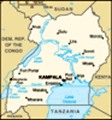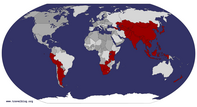Advertisement
Published: December 17th 2013
I was not immediately enthusiastic about the prospect of trekking to see the gorillas. Before I arrived here, it didn’t feature in my metal list of things to do in Africa. The obvious objection is that it’s ruinously expensive, but I was also pretty dubious about the ecotourism claims. Surely it can’t be good to tramp out into the forest and hassle severely endangered wild animals? To encourage human contact? But over months spent in East Africa, I heard people rave about it over and over again. Everyone said the same thing. You have to do this. It was unanimous. When I met some researchers from London’s Natural History Museum who said it was amazing and totally legitimate from an ecological point of view, I decided maybe I was being a little hasty in dismissing the idea.
So I looked into it. Only a small number of gorilla families are chosen to be ‘habituated’ to human contact, the vast majority are left in peace. They are only visited for an hour each day, with strict rules in place to protect them. A limited number of tracking permits are issued daily. The money this generates allows for maintenance of the national
park, and protection from poachers. The gorilla population in the forest has increased substantially since the scheme has been in place. It seems like a pretty good deal for the gorillas. Not so much for the indigenous Batwa people, who were evicted from their home when it became a protected area, but that’s another story. Two of my lovely doctor friends from the Tropical Medicine course are spending a year volunteering at a genuinely amazing little community hospital which works with the displaced tribes. You may even meet them if you stay in one of the lodges near Buhoma gate. Part of their job is to promote the work of the hospital, so they’re happy to chat to visitors or arrange a tour of the hospital if you’re interested in learning more. Very few tourists are aware of the human impact of conversation, so it’s a really worthwhile thing to do if you want to be a responsible traveller and maintain a balanced view. www.bwindihospital.com. It’s entirely charity funded, so donations are always gratefully received.
Anyway, I’m getting sidetracked.
We purchased our tracking permits at a discount ($350 instead of $500… gorillas don’t come cheap), because it’s rainy
season and we were assured that we were certain to get wet.
Having had a little bit of a packing fail, I didn’t actually bring a waterproof with me, so in preparation for the trek I went to Owino Market in Kampala to wade through piles of second hand clothes shipped in from Europe and the US. Such markets are big business in Africa, and in amongst the mounds of junk you can find some amazing things. I know a girl who got her wedding dress for a fiver from Memoria Market in Moshi. They also explain the strange phenomenon of locals wandering the villages wearing deeply incongruous T-shirts. London Marathon 2008. Birmingham Pride (in a country where homosexuality is illegal). University of Leeds Netball Team (complete with embroidered nickname, worn by someone of the wrong gender).
The Kampala market is vast, filthy and chaotic, with stalls collapsing in on each other in a way that prevents any light filtering down to the narrow lanes. I pushed my way through, gently brushing off the people grabbing at my arms. Eventually, lost somewhere in the middle and exasperated by the total lack of order, I asked someone to show


me where I can find what I’m looking for. I was led deeper into the scruffy labyrinth, to an alleyway which was clearly the designated coat area. Stallholders lined up to offer me what they felt was their most waterproof looking jacket, a property they seem to equate purely with shininess. Unconvinced, I opened up my drinking water bottle and splashed all the proffered items. I am baffled by the things that have ended up here. There’s some expensive snowboarding gear, plenty of 80s sportswear that would cost a fortune in a fancy London ‘vintage’ store, leather jackets, various items emblazoned with western company logos. All of it is either too big, too heavy or not remotely waterproof. Eventually I find something suitable, a bright green glossy plastic mac with a pointy hood, reminiscent of something I used to wear to nursery school when I was 5. It is hideous. I love it, and purchase it for around £1.75. This process takes most of the afternoon. On my way out, I also can’t resist buying 5 t-shirts, some leather sandals and a skirt.
Obviously, after all of this, it didn’t rain a drop.
So I went gorilla bothering
with 7 other people from the Trop Med course. We booked a 5 day trip with a travel company which also included chimpanzee tracking and safaris at Queen Elizabeth national park. Though all of this was good, if you are able to get to Bwindi independently, I would strongly advise taking a DIY approach. Everything we did would have been straightforward to arrange ourselves at maybe half the price, and probably more enjoyable without the amazing collapsing tents we were provided with, which became less and less amusing each night.
Anyway. There are three habituated gorilla families wandering freely around this part of the forest, though they do tend to have their own established territories within which they are generally found. Because of this, depending on which group you are tracking, the walk can take anything from 20 minutes to 8 hours. Since this was the single most expensive day in my entire travelling career, I was secretly hoping to be assigned a Gorilla group that was absolutely miles away, preferably at the other end of an arduous hike involving mild peril. In order get my money’s worth. This makes sense in my head. Assuming the rangers would decide


how far we were going on the basis of who looks fittest and least likely to have some kind of coronary event, I attempted to look alert and active. This involved standing up very straight and tucking my trousers into my socks. I need not have worried. When we assembled for the briefing, our group’s presence lowered the average age by about 30 years. One middle-aged American woman was actually spherical. There were two other young girls, but they seemingly felt that appropriate trekking gear consisted of skinny jeans, white trainers and a hoody. We were dispatched to the far away group.
There were rules. One hour with the gorillas, tops. Maintain at least 7 meters distance at all times. No loud noises, sudden movements, camera flash. Professional trackers had gone ahead of us, early in the morning, to locate the group and radio back their location. We set off to penetrate the impenetrable forest. At first it was easy, but the paths gradually faded, becoming steeper and less well defined. We found the group after around two hours. As we approached, the track finally vanished, leaving us scrambling through the undergrowth behind our guide’s swinging machete.
We
abandoned our bags a little distance away and crept forwards. I say crept… there was a lot of slipping and cracking of branches, perhaps a small amount of swearing. We aren’t very stealthy. Our guide assured us we were close, though none of us could see them. The trees thinned out to leave a clearing overhead, but the ground was thick with tangled vines, almost shoulder height. The silverback definitely saw me before I saw him. This was not 7 meters away. The terrain meant there was only one way of approach, which forced us in close.
He was reclining in the middle of a huge bush, grabbing handfuls of vegetation from all directions, nimbly stripping leaves from stalks with his fingers and teeth. Completely focused on the task of eating, serenely indifferent to our presence. There were certain, unexpected things that struck me about his appearance. Dexterous hands, like soft black leather gloves. Disproportionately tiny ears. Expressive, mildly comic eyebrows. Warm, amber eyes.
After a while the silverback tired of our presence and lumbered past (I wouldn’t call him graceful) to hide deeper in the undergrowth. We moved on, to visit different members of the family. A

 Chimps
Chimps
The chimp trek we did the day before was less successful. It mostly involved the guide wandering around in a circle muttering "I'm sure they were around here somewhere". We never found them.young female climbed high into the canopy, cautiously testing the sturdiness of a dead tree, probing for terminates. Two others rested in a shady hideout. We crawled in to join them. One yawned, stretched, flopped backwards, beat her fists on her chest and then drifted off to sleep. If I had to describe these gorillas in human terms, I’d say they seemed pretty chilled out. I found them calming to be around. I had expected the experience to be a little scary, but at no point was I ever nervous. The gentle giant cliché fits well.
The hour few past. On the way home, our guide recounted stories of things he’d seen during his 7 years doing one of the strangest jobs on the planet. Overly boisterous youngsters who’d floored tourists accidentally with a playful push. The time a wild rival male threatened the trekkers, and the habituated silverback charged through the middle of the group, without touching a single person, to chase the attacker away.
On arriving back at the entrance we were issued with certificates to commemorate our experience, and informed tips could either be left in the tip box or, if we prefer, we could
“appreciate our guides physically”. Assuming something had been lost in translation here, I chose the tip box. On the way back our otherwise useless driver redeems himself by spectacularly off-roading the minibus up a steep bank and through the bush, to get around a lorry which has firmly wedged itself at an improbable angle on a single lane dirt track in the middle of 'lion country'.
Half way back to Kampala we dropped by a tiny village so Claire, one of the other doctors, could visit the mother of a friend. She had never met this lady before. The friend is a Ugandan medical student abroad in Europe, she hadn't seen her family for a long time and wanted Claire to stop in and say hi. The rest of the group had absolutely no connection to this whatsoever, but we were invited nonetheless. On arrival we discovered that they'd cooked an enormous meal for all 8 of us, vast quantities of food. We had already eaten lunch, but we dug in. Quite simply, they considered us their friends because we are friends with a friend of their daughter, and though they had no clue at all who we were, they were genuinely delighted to have us all there. Even though we barely fit in their house. Claire was presented with gifts... 4 woven matts, 3 kangas, 2 pineapples and a bible. That's Ugandan hospitality.
Advertisement
Tot: 0.166s; Tpl: 0.016s; cc: 25; qc: 81; dbt: 0.0825s; 1; m:domysql w:travelblog (10.17.0.13); sld: 1;
; mem: 1.3mb













D MJ Binkley
Dave and Merry Jo Binkley
Terrific
We hope to do this some day. Sounds like a fantastic experience. What a wonderful experience to have lunch with the friend of a friend of a friend's family.